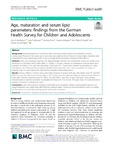Age, maturation and serum lipid parameters: findings from the German Health Survey for Children and Adolescents
Schienkiewitz, Anja
Truthmann, Julia
Ernert, Andrea
Wiegand, Susanna
Schwab, Karl Otfried
Scheidt-Nave, Christa
Background
Recommendations on preventive lipid screening among children and adolescents remain controversial. The aim of the study was to assess age and puberty-related changes in serum lipids, including total cholesterol (TC), and high-density (HDL-C) and non-high-density lipoprotein cholesterol (Non-HDL-C).
Methods
Using cross-sectional data from the National Health Interview and Examination Survey for Children and Adolescents in Germany (KiGGS 2003–2006; N = 13,676; 1–17 years), changes in distributions of serum lipids were visualized according to sex, age and maturation. Youth aged 10–17 years were classified as prepubescent, early/mid-puberty, and mature/advanced puberty. Multiple linear regressions were used to quantify the impact of pubertal stage on serum lipid levels, adjusted for potential confounding factors.
Results
Among children 1–9 years mean serum lipid measures increased with age, with higher mean TC and Non-HDL-C among girls than boys. Among children 10–17 years, advanced pubertal stage was independently related to lower lipid measures. Adjusted mean TC, HDL-C and Non-HDL-C was 19.4, 5.9 and 13.6 mg/dL lower among mature/advanced puberty compared to prepubescent boys and 11.0, 4.0 and 7.0 mg/dL lower in mature/advanced puberty compared to prepubescent girls.
Conclusions
Lipid concentrations undergo considerable and sex-specific changes during physical growth and sexual maturation and significantly differ between pubertal stages. Screening recommendations need to consider the fluctuations of serum lipids during growth and sexual maturation.

